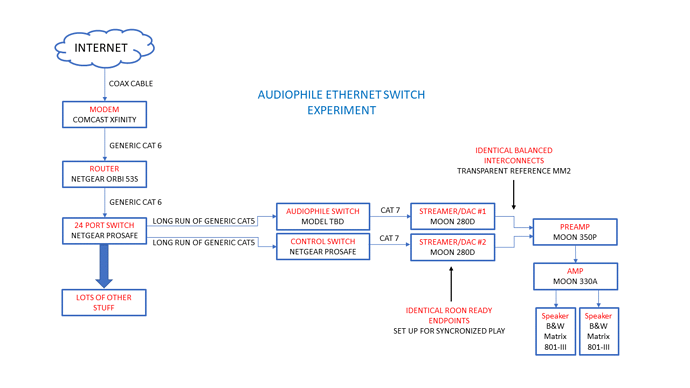In “The Value of Audiophile Switches” thread I proposed an experiment to see if I could detect any changes in SQ with the addition of an audiophile switch to my system. As this thread has been suspended, I’ve started this new thread for those who expressed interest in my findings.
The audiophile switch used was an English Electric 8. This setup allowed me to seamlessly switch back and forth between the two balanced inputs on my preamp while playing identical streams to the two endpoints connected to these inputs. To my surprise, the preamp was able to switch between the inputs without producing any delay, dead-time, or strange noises allowing a quick and accurate comparison between the control and test signal paths.
My wife was in charge of Ethernet cable swapping, which was done while I was out of the room, so that I did not know which switch was inserted into each signal path.
The program material was mostly a mix of jazz, classical, and blues selections I am familiar with and that have good imaging and SQ. Most were local files, some were Qobuz. For fun I included a few 1970’s favorites that don’t, in my opinion, sound so good regardless of the playback chain.
To start, I compared the SQ of the two streamers without either the control or audiophile switches inserted. I felt it was essential to verify that the sound from the two signal paths was indeed indistinguishable from each other. Not surprisingly, I could not detect any difference in SQ between these two signal paths.
Next, I inserted the control switch but left out the audiophile switch to make sure that this $29 switch was not in some way degrading SQ and invalidating the experiment. Again the two signal paths were indistinguishable from each other.
Finally I inserted the audiophile switch into the mix, and did some extensive listening. I had my wife reconfigure which switch was in which signal path a number of times, to remove as much bias from the experiment as was practical. Throughout this testing, I was never able to perceive any differences in tonality, transient reproduction, or soundstaging. Indeed, to me, the streams sounded indistinguishable from each other on all the program material.
If you believe the networking experts, this is hardly unexpected. If you believe happy owners of audiophile switches (including the audio professionals who let me demo this switch and whose opinions I value), my ears and/or system must not be good enough to appreciate the benefits. I’m not interested in debating which is true, I’m merely presenting my results for those who asked to see them. I will, however, be happy to give more detail about the testing if there are any questions.
A few notes on the English Electric 8 switch: This is a very attractive piece of audio kit. The case is handsomely designed, and it feels quite substantial compared to the typical datacom switch. The cables and power go in the back, and there are power and link indicator lights for each port on the front panel. Unlike most switches, the lights are dim and will not overwhelm the listener if the switch is visible in an equipment rack.



 certainly the Lumin’s dont
certainly the Lumin’s dont